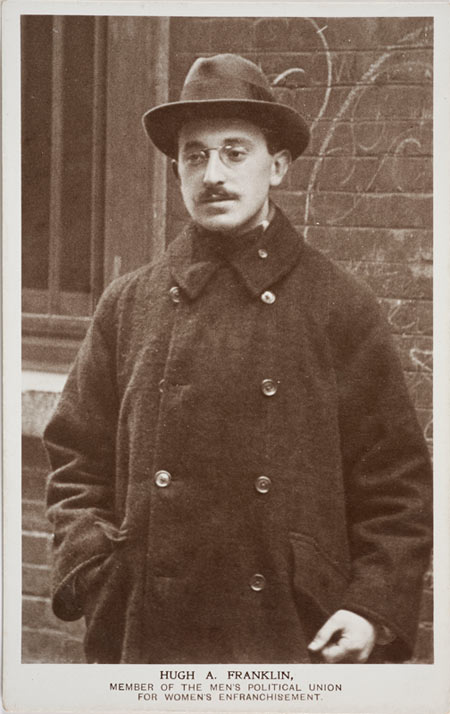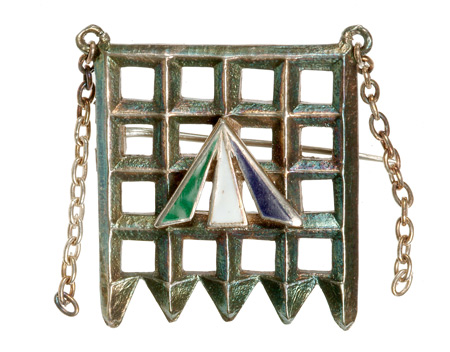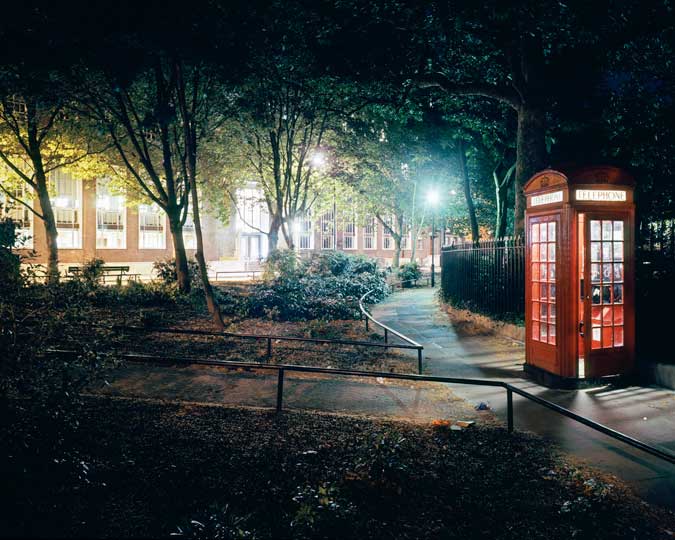The Suffragette hunger strike protest remains one of the most poignant and disturbing aspects of the struggle for Votes for Women. Suffragettes in British prisons refused to eat, and often to drink, threatening to starve themselves to force a response from the authorities. Here are six key facts about this extraordinary struggle.
1: Hunger strikes started as an act of individual defiance
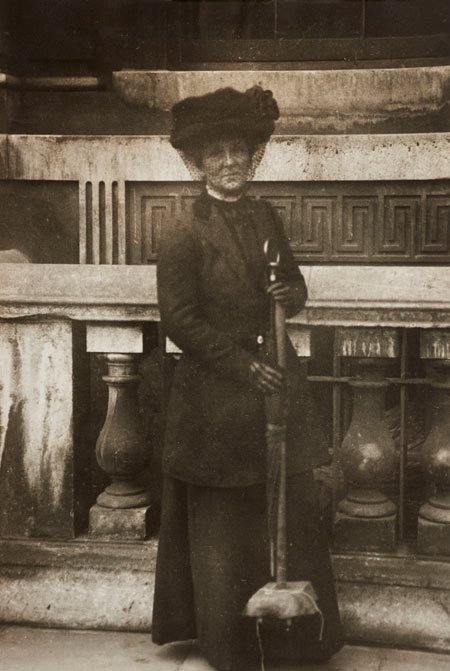
Posing in front of a reconstruction of the message she stencilled on the wall of the House of Commons on June 22 1909. Refusing to pay a fine for the offence, Marion was sent to prison for one month.
Some of the people who campaigned for women's right to vote used militant tactics like attacking property, which often led to prison sentences. Hunger striking was a dangerous form of non-violent protest that could be carried out from inside prison.
This ultimate form of prison protest did not, however, originate from Suffragette headquarters at the Women's Social and Political Union. Initially it was the lone action of a single Suffragette, Marion Wallace Dunlop. In 1909 Marion was sent to Holloway on a charge of wilfully and maliciously damaging the stonework of the House of Commons.
Classified as a "second division", criminal prisoner, she went on hunger strike in protest against not being placed in the "first division" as a political prisoner. Leading Suffragette Christabel Pankhurst said that Marion had begun the strike "taking counsel with no one and acting entirely on her own initiative".

The Suffragette newspaper, 25 July 1913
The Doctor: "This Woman is very weak, but I think at a pinch she could stand another twenty-five minutes."
The Prime Administer: "Twenty-five minutes! Ah well, never let it be said we do not temper our injustice with mercy, let her out in twenty."
Marion Wallace-Dunlop began her hunger strike on 5 July 1909 and refused all food for several days. When the prison doctor asked her what she was going to eat, she replied: "My determination". He answered: "Indigestible stuff, but tough no doubt." After 91 hours of fasting, Marion was released by prison authorities afraid that she might die.
Following Marion’s lead, other Suffragette prisoners quickly adopted the hunger-strike. Initially the protest resulted in the release of the prisoners as soon as they showed signs of weakness.
The Suffragettes Charlotte Marsh, Laura Ainsworth and Mary Leigh were arrested in September 1909 for disrupting a meeting attended by the Prime Minister Herbet Asquith. All three were sentenced to two weeks' imprisonment in Winson Green prison, Birmingham. They immediately decided to go on hunger-strike.
2: Suffragettes were forcibly fed by prison authorities
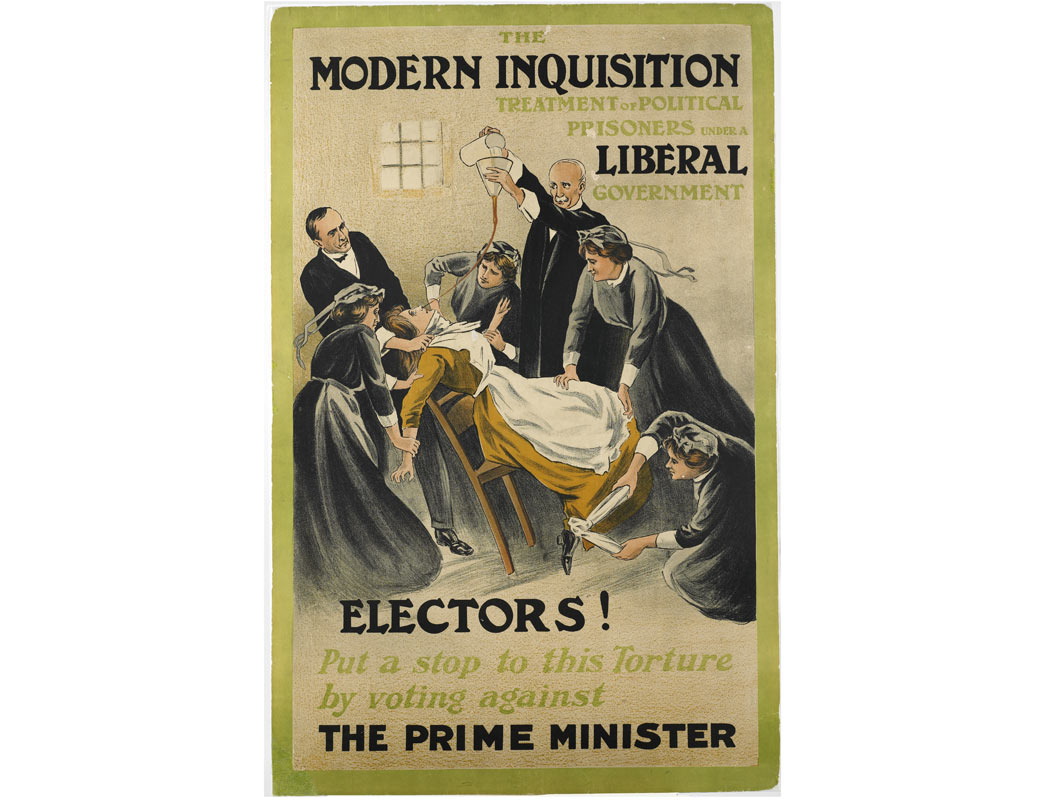
The modern inquisition, treatment of political prisoners under a liberal government, 1910
Election poster by Alfred Pearse issued by the Women's Social and Political Union denouncing the Government's treatment of suffragette prisoners.
Very soon, the authorities decided to introduce forcible feeding of hunger striking prisoners. This involved prison warders, wardresses and medical staff restraining the prisoner while forcing a rubber tube into their mouth or nose. Mixtures of milk, eggs or other liquid foods were poured into the stomach. Struggling Suffragettes could suffer broken teeth, bleeding, vomiting and choking as food was poured into the lungs.
Emmeline Pankhurst, founder of the Women's Social and Political Union, described one London prison during a period of force-feeding: "Holloway became a place of horror and torment. Sickening scenes of violence took place almost every hour of the day, as the doctors went from cell to cell performing their hideous office."
The Women's Social and Political Union issued graphic illustrations and descriptions of women struggling and being restrained whilst a tube was forced down their throat or up their nose. These shocking revelations caused considerable public concern at such brutal treatment by the authorities on vulnerable women.

Tortured Women. What forcible feeding means, 1914
An account by the suffragette prisoner Mary Richardson in a WSPU leaflet.
3: Men went on hunger strike as well as women
Male supporters of Votes for Women also used the hunger strike tactic. Hugh Franklin was a member of the Men's Political Union for Women's Enfranchisement, the WSPU's counterpart. After taking part in the 'Black Friday' demonstration of November 1910, he took a whip to Home Secretary Winston Churchill, whom he held responsible for violent policing during 'Black Friday'. For this Hugh was imprisoned in Pentonville prison, where he went on hunger strike.
Hugh Franklin served two more prison sentences for his pro-suffrage activities, continuing to go on hunger strike. He was temporarily released from prison under the 'Cat and Mouse' Act, and was able to escape Britain to the Continent. What was the 'Cat and Mouse' Act, you ask?
4: Suffragettes played a dangerous game of 'Cat and Mouse' with the government
In 1913 the British government, fearing the death of a hunger-striking prisoner, passed the Prisoner's (Temporary Discharge for Ill-Health) Act.
The Act became known by Suffragettes as the Cat & Mouse Act. It allowed hunger striking Suffragettes to be released from prison when they were weakened, but only 'on licence'. The prisoner would be taken back into prison to serve the remainder of their sentence when their health improved or they re-appeared in public. This was condemned as cruelly 'letting prisoners go and catching them again', just as a cat plays with a mouse.
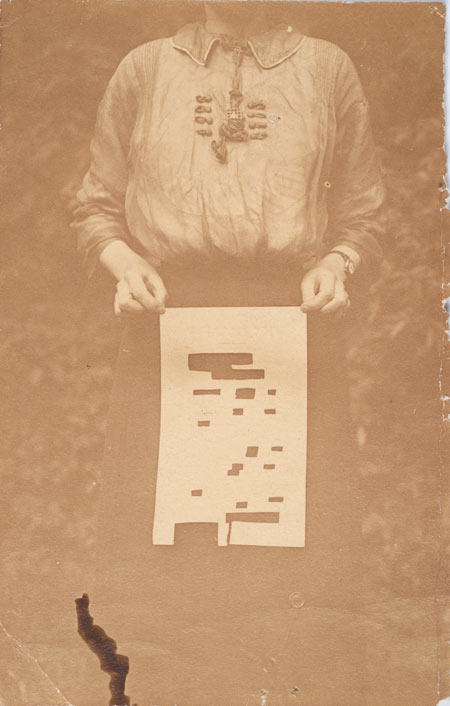
This 'Cat and Mouse' licence was issued to the Suffragette Gertrude Mary Ansell on her release from Holloway prison on 6 August 1913. This notice refers to Gertrude's arrest and imprisonment for smashing a window at the Home Office on 31 July 1913. For this offence she was sentenced to one month in Holloway where she immediately went on a hunger-and-thirst strike.
However, many Suffragettes took the opportunity of freedom to remain on the run from the authorities taking refuge in a number of safe houses. Once recovered, they emerged unnoticed to undertake more militant 'outrages'. Gertrude failed to return to Holloway on 14 August, as this licence ordered her to. Instead, she remained free until 30 October when she was spotted selling The Suffragette newspaper at Holborn Tube station
Some Suffragettes brazenly left their Cat & Mouse Act licence at the scene of arson attacks, with personal details cut out. It is known that the multiple arsonist Kitty Marion certainly used this tactic to taunt the police, undertaking militant acts whilst supposedly recovering from hunger-strike. It is possible that Kitty is depicted in this photograph, holding her anonymised licence.
5: The Suffragettes treated hunger striking like a military campaign

Letter to a hunger-striking Suffragette, 1912
Written by Mabel Tuke. Such letters accompanied the hunger-strike medals sent to prisoners on their release.
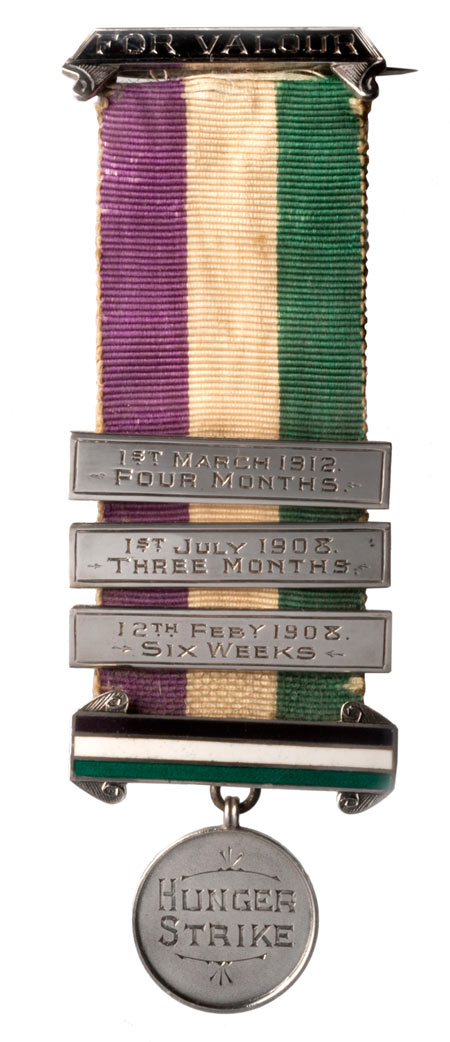
The leadership of the Women's Social and Political Union rewarded Suffragette prisoners with a range of military-style campaign medals. Those who served terms of imprisonment with hunger-strike were presented with Hunger Strike medals at breakfast receptions on their release.
Silver bars on the medal represented periods of hunger-strike, whilst the enamel bars represented periods of force-feeding.
One of the most iconic objects in the Museum’s collection is the hunger strike medal presented to the Suffragette leader, Emmeline Pankhurst. The medal refers to a two month prison sentence with hunger-strike served by Emmeline in 1912 for throwing a stone at a window of 10 Downing Street, the Prime Minister’s residence.
Whilst in Holloway, Emmeline was also charged with ‘conspiring to incite certain persons to commit malicious damage to property’ and sentenced to a further nine months’ imprisonment.
A second Holloway medal was engraved with the prison wing and cell number occupied by Suffragettes. Prisoners were also entitled to the Holloway medal, designed by Sylvia Pankhurst. The silver and enamel brooch incorporates the portcullis emblem of the House of Commons and a central broad prisoner’s arrow in purple, white and green enamel. It was first presented to ex-suffragette prisoners at a mass demonstration at the Albert Hall on 29 April 1909.
6: Hunger and thirst strikes could be deadly

The Suffragette Elsie Howey in a Replica Prison Cell
Replica prison uniforms were often worn by Suffragette ex-prisoners at demonstrations and fund-raising bazaars to highlight the conditions under which imprisoned Suffragettes were held.
There were no cases of a Suffragette dying in prison while on hunger strike. However, hunger striking was often deeply damaging and always carried the risk of serious injury.
Elsie Howey served several terms of imprisonment with hunger strike. In a letter to the Suffragette Fellowship her mother, also a Suffragette campaigner, noted that Elsie had required four months' medical treatment to recover from force feeding: "Her beautiful voice was ruined."
Mary Clarke was the younger sister of Emmeline Pankhurst, and was arrested in the "Black Friday" protest on 18 November 1910. In Holloway Prison she endured a hunger strike and forced feeding. She was released due to weakness on 23 December 1910, but three days later Emmeline found her unconscious, and she died soon afterwards: a result of a burst blood vessel on the brain. The violence of force feeding might well have been responsible, and Emmeline Pethick-Lawrence described Mary Clarke as "the first woman martyr who has gone to death for this cause."
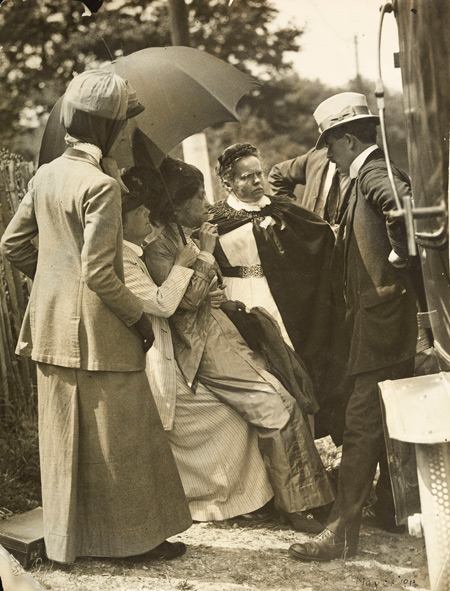
Rearrest of Emmeline Pankhurst, 26 May 1913
Emmeline was rearrested whilst recuperating at the home of the composer Ethel Smyth in Woking. Emmeline, still weakened by hunger strike, is here seen fainting back on the knee of Ethel.
Unlike her fellow Suffragettes, Emmeline Pankhurst was never force-fed by the authorities. This brutal and invasive treatment was regarded as too controversial to inflict on such a high profile leader who, by this time, was in her 50s. Nonetheless, her health suffered due to hunger striking.
In April 1913, Emmeline Pankhurst received her final prison sentence of three years' penal servitude, for incitement to place an explosive in a building at Walton, Surrey. She again went on hunger strike and was subsequently released from Holloway after several days.
On her recovery, she was rearrested under the terms of the Cat and Mouse Act and thus began a pattern of hunger strike, release, recuperation and re-arrest that continued until the end of July, when the police finally decided not to re-arrest her.
During each period of recuperation from hunger strike Emmeline Pankhurst found refuge in a number of safe houses and was always nursed back to health by her nurse Catherine Pine.
Suffragette hunger striking came to an end in Britain in 1914, when the Women's Social and Political Union suspended militant action for the duration of the First World War. The Representation of the People Act, passed in 1918, gave some women the right to vote for the first time in Britain. However, the use of the hunger strike continued around the world in nations like Australia. American suffrage campaigners, like Alice Paul, went on hunger strike while imprisoned in 1917 for campaigning for the right to vote.








